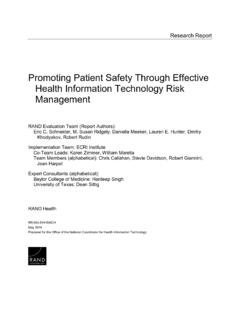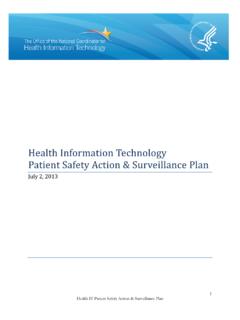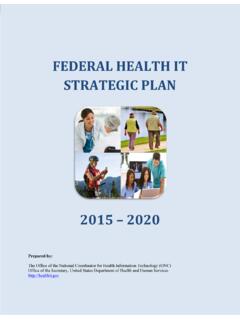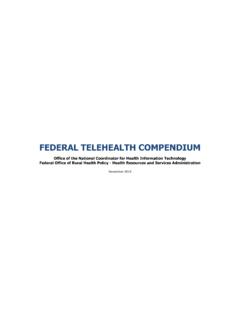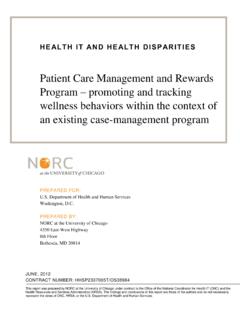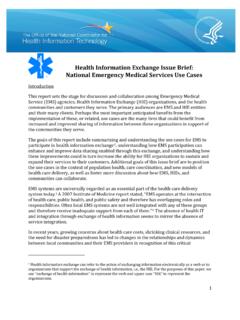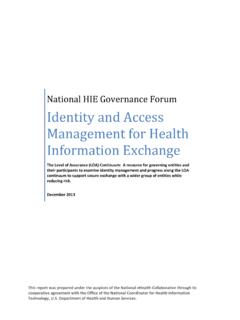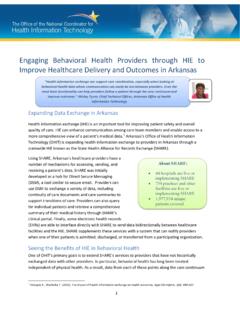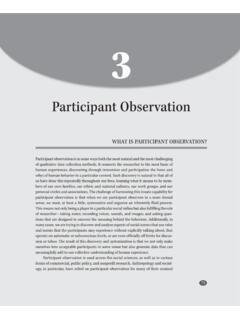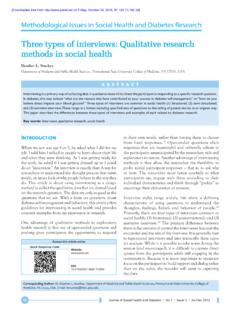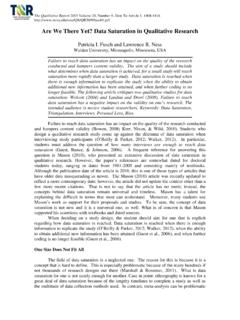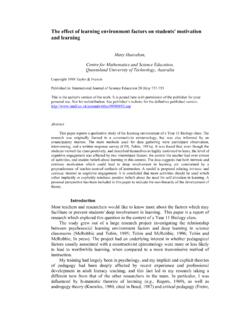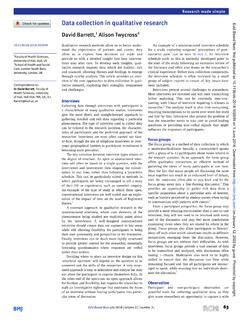Transcription of Standard Nursing Terminologies: A Landscape Analysis
1 Standard Nursing Terminologies: A Landscape Analysis MBL Technologies, Clinovations, Contract # GS35F0475X Task Order # HHSP2332015004726 May 15, 2017 Identifying Challenges and Opportunities within Standard Nursing Terminologies 2 Table of Contents I. Introduction .. 4 .. Analysis Approach .. of Background Data .. 7V. 8 A. Reference Terminologies ..8 1. SNOMED CT .. 82. Logical Observation Identifiers Names and Codes (LOINC) .. 10B. Interface Terminologies .. 11 1. Clinical Care Classification (CCC) System .. 112. International Classification for Nursing Practice (ICNP) .. 123. NANDA International (NANDA-I) .. Omaha System .. 166. Perioperative Nursing Data Set (PNDS) .. 187. Alternative Billing Concepts (ABC) Codes .. 19C. Minimum Data Sets .. 20 1. Nursing Minimum Data Set (NMDS) .. 202. Nursing Management Minimum Data Set (NMMDS) .. IT Developers - Perspective .. Issues in Using SNTs.
2 241. Lack of Alignment on Terminology Standards for Nursing Content Definition .. 242. Customized Development and Implementation of EHR Systems .. 243. Resource-Intensive Mapping Requirements, Curation and Maintenance .. 244. Licensing Fees, Copyrights and Associated Pricing Challenges .. 255. Incomplete Electronic Documentation of Nursing Care .. 254. Nursing Interventions Classification System (NIC) and Nursing Outcomes Classification (NOC) .. 15 Identifying Challenges and Opportunities within Standard Nursing Terminologies 3 VIII. Conclusion .. 26 Appendix A: Expanded Nursing Terminologies Timeline .. 27 Appendix B: Pre-Determined Landscape Assessment Questionnaire .. 34 Appendix C: EHR Developer Assessment Questionnaire .. 35 Appendix D: List of Abbreviations .. 36 References .. 38 Identifying Challenges and Opportunities within Standard Nursing Terminologies 4 I. Introduction With the rapid adoption of health IT and the promotion of interoperability to improve health, consistent standards and common data elements are the foundation for the advancement of care models.
3 This advancement is based on objectives such as capturing sharable patient and care information across disciplines and care settings, enabling more accurate and less burdensome measurement of the quality of care delivered, and supporting ongoing research and Analysis . Within this context, the Nursing profession can contribute an enormous amount of valuable data related to the care of the patient and the Nursing process. However, if Nursing data are not stored in a standardized electronic format, or easily translated to a vocabulary used by interdisciplinary care team members, the value and contributions of Nursing to patient outcomes may not be measurable or retrievable (Welton & Harper, Measuring Nursing Care Value, 2016). With more than million members, nurses constitute the largest workforce in health care, and hospital-based nurses spend as much as 50 percent of their time in direct patient care (Hurst) ( Nursing Fact Sheet, 2011) (McMenamin, 2016).
4 As we move forward with innovative strategies to optimize the health of patients and communities, the omission of Nursing data due to a lack of agreement on a standardization strategy would be unfortunate. To this end, the Office of the National Coordinator for Health IT (ONC) is working with MBL Technologies and Clinovations Government + Health, Inc. (Clinovations GovHealth) (hereafter the project team) to conduct a Landscape assessment to better understand the current state and challenges associated with using terminologies and classifications to support Nursing practice within health information technology (health IT) solutions. Through a literature review and interviews with terminology owners, this assessment examines the current state of development and usage within the 12 Standard Nursing Terminologies (SNT) recognized by the American Nurses Association (ANA).
5 This report: Defines a brief history of the development of Standard Nursing terminologies and efforts to gainconsensus on a strategy for their use; Includes the level of advancement and interoperability of individual terminologies withelectronic health records (EHRs); and Identifies themes in the form of challenges and terminologies and vocabulary structures first developed in 1973, and many have changed significantly since their inceptions. Realizing that the standardization of Nursing care documentation was a critical component to support interoperable health information, the ANA in 1989 created a process to recognize languages, vocabularies and terminologies that support the Nursing practice (ANA, 2015). Current action plans and guidelines, descending from the work of individuals such as James J. Cimino and organizations such as the National Committee on Vital and Health Statistics (NCVHS) and the ANA, continue to be refined (Cimino J.)
6 , 1998) (Cimino, Hripcsak, Johnson, & Clayton, 1989) (Sujansky, 2002). However, the inability to ensure the availability of sharable and comparable Nursing data remains an issue. Increased focus on longitudinal and interdisciplinary documentation, care quality and value Identifying Challenges and Opportunities within Standard Nursing Terminologies 5 precipitates a need to accurately quantify the contribution of each care team member for optimization of care workflows across settings. Further, high-quality Nursing data can assist in the optimal integration of registered nurses into high-value, lower-cost approaches to longitudinal care (Welton & Harper, Measuring Nursing Care Value, 2016). Figure 1 below provides a high-level timeline of significant events that have occurred in the evolution and development of SNTs. A detailed and expanded events timeline is in Appendix A. Figure 1.
7 Consolidated SNT timeline Currently, the ANA recognizes two minimum data sets, two reference terminologies and eight interface terminologies for facilitating documentation of Nursing care and interoperability of Nursing data between multiple concepts and nomenclatures within IT systems (ANA, ANA Recognized Terminologies that Support Nursing Practice, 2012). The definitions of each of these types of terminologies are as follows: Minimum data sets are ..a minimum, essential set of data elements with standardizeddefinitions and codes collected for a specific purpose, such as describing clinical Nursing practiceor Nursing management contextual data that influence care (Westra, Delaney, Konicek, &Keenan, Nursing standards to support the electronic health record, 2008). Interface terminologies (point-of-care) include the actual terms/concepts used by nurses fordescribing and documenting the care of patients (individuals, families and communities)(Westra, Delaney, Konicek, & Keenan, Nursing standards to support the electronic health record,2008).
8 Reference Terminologies are designed to ..provide common semantics for diverseimplementations (CIMI, 2013) and ideally, they enable clinicians to use terms appropriate for their discipline-specific practices, then map those terms through a reference terminology to Identifying Challenges and Opportunities within Standard Nursing Terminologies 6 communicate similar meaning across systems (Westra, Delaney, Konicek, & Keenan, Nursing standards to support the electronic health record., 2008). Table 1 below includes the 12 SNTs by category. Table 1. ANA-Recognized Standard Nursing Terminologies Interface Terminologies Minimum Data Sets Care Classification (CCC) Classification for NursingPractice (ICNP) American Nursing DiagnosisAssociation International (NANDA-I) Interventions Classification System(NIC) Outcomes Classification (NOC) Nursing Data Set (PNDS) Minimum Data Set (NMDS) Management Minimum DataSet (NMMDS)Reference Terminologies Observation Identifiers Namesand Codes (LOINC) Clinical Terms (SNOMED CT) Analysis ApproachThe project team first performed an internet search to obtain background on Standard Nursing terminologies.
9 Using information gathered in the search and focusing specifically on ANA-recognized SNTs, the project team proposed a list of interview contacts within each ONC-validated SNT organization. Interviews were conducted using an interview guide (Appendix B). For accuracy purposes, the project team used standardized definitions for the variables of current usage, existing interoperability and major barriers or issues to implementing and using SNT. Data on the following topics was collected for Analysis : SNT goals and objectives for the terminology ; Terminology versioning and release schedules; Latest version of SNT as well as update timing and methodology; Current usage and activities; Maintenance and sustainability issues; Level of interoperability with electronic health records; Major issues or barriers associated with integration and implementation; and The future state of the touched on each SNT s perceived or actual barriers to interoperability, how easily an SNT is implemented within an EHR, and the typical process for that implementation.
10 Details of those interviews are in Section IV: Summary of Background Data, below. After completion of interviews with terminology representatives, the project team approached three electronic health record developers to provided background on how SNTs are implemented and used in hospital and ambulatory health information technology applications. Although these interviews were Identifying Challenges and Opportunities within Standard Nursing Terminologies 7 unstructured , the project team developed a framework for guiding the discussion (Appendix C). Developer interviews were collated and overarching perspectives were identified for further discussion in Section VI: Health IT Developers - Perspectives. When all data collection was complete, the project team evaluated the information to identify gaps, similarities, barriers, challenges and opportunities related to the current status and use of SNTs.
